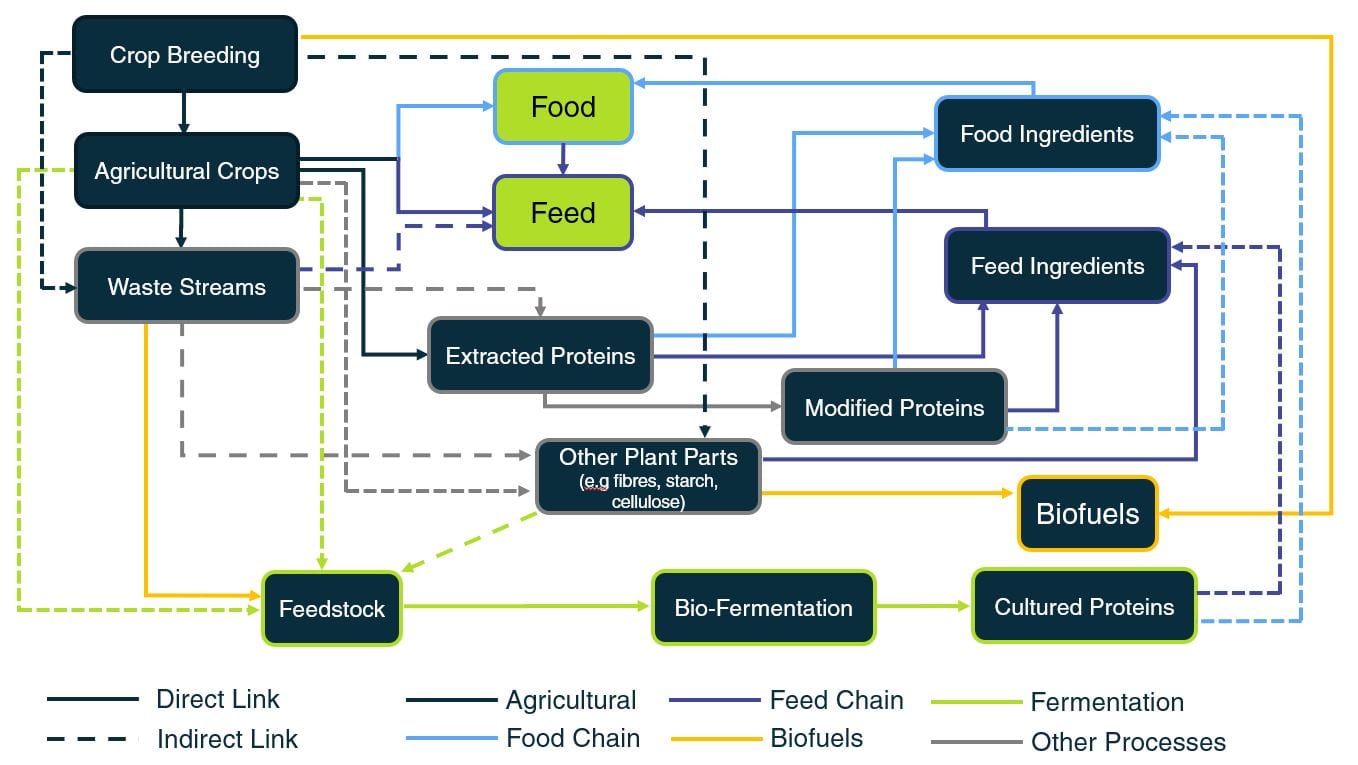We are looking into a future where our proteins will partly come from crops grown in fields, glasshouses or vertical farms and partly made in bioreactors using animal and plant cells or more interestingly hydrogen and CO2 from air (gas fermentation). Although we are not yet seeing a reduction in the numbers of livestock farmed, recent dietary trends suggest that there is a shift towards healthier foods, including plant based vegan and vegetarian diets.
Looking to the future, all possible solutions should be considered so that we can generate a balanced coexistence of agriculture and biotechnology solutions that do not harm the environment, meet the overall protein demand in the human diet and are aligned with consumer demand and acceptance.
Cultured proteins
Recent years have seen an increase in cultured/fermented proteins as alternatives to animal derived protein. It is claimed that the environmental impact of producing cultured proteins is significantly less than the impact of growing the same amount of proteins using traditional agriculture. However, sustainable energy and appropriate feedstocks will be needed to operate a viable and sustainable fermentation enterprise on an industrial scale. Currently sugar – produced by traditional agricultural methods with significant environmental impact – is the most commonly used feedstock in bio fermentation for cultured protein production.
However, as farming moves towards more regenerative agricultural practices, we would expect that it could provide manufacturers of cultured protein with a wider range of feedstocks with reduced environmental footprint as an alternative to sugar to match an ever-growing range of applications.
This opportunity for a collaboration among the different sectors (crop breeding, agriculture, biotechnology, biorefinery, food and feed, etc) can significantly contribute to achieving and maintaining net zero by using methane or CO2, waste materials and other carbon sources as feedstocks for protein production.
Hybrid meat
In the journey towards a meatless diet, the use of plant proteins on their own provides several challenges for food developers aiming to meet consumers’ expectations of a ‘meat like’ alternative. As such ‘hybrid’ meat, a mixture of meat (either natural or grown from cultured cells) and plant protein/products could provide a potential solution to produce meat-like ‘meat’ with the appropriate nutritional, structural and taste profile.
Using cell-based protein and fat molecules grown in a bioreactor and mixing these with plant proteins from an agricultural crop to turn them into a food product could be seen as a clear illustration of how traditional agriculture and biotechnology can work together to provide an optimal protein supply for our diet.
Plant proteins
The search for novel plant proteins to meet the needs of the increasing number of people moving to vegetarian and vegan diets and those with other dietary/allergy requirements, as well as the use of plant proteins in the formulation of a wide variety of food products is also a key challenge for the sector. Protein composition, digestibility, and technological functionality are key considerations alongside cost, regulatory compliance and new methods of production, i.e. how to grow these proteins.
The growing demand for more diverse protein solutions means more opportunities for growers: for example identifying and growing underutilised crops, breeding and growing crops for high protein yield, crops as feedstocks, breeding crops with specific composition, such as nutrients, protein, even harvesting crops from the sea.
The agricultural waste and unused plant parts can then either be recycled (eg ploughed back into the field) or used as feedstock for bio fermentation.
In conclusion
When considering future protein production systems, it will be essential to take account of consumer needs and preference. While cellular agriculture (lab-grown food using animal [and plant] cells) has much to offer, how it is viewed by the consumer will impact its uptake and overall market share. The sensory properties of a food product are generally recognised in the industry as being more important than ethical and even cost considerations. People eat food that they like, above all, and this will likely never change. Cultured or hybrid meat has the potential to provide more ethical or healthier alternatives for those who like the taste of meat, but it will not meet the requirements of those wanting a truly meatless diet: for these consumers plant based products will be needed.
To provide a healthy, nutritiously balanced diet that can be produced in a sustainable manner, a range of complementary approaches will have to be brought together – ranging from agricultural to biotechnological production – rather than relying on a single method or approach. There is a demand for expertise to oversee the inter connectivity among current solutions and to improve both agricultural and bio fermentation pathways to supply the growing population with digestible, nutritious, functional and affordable proteins.
To meet our future needs much work still needs to be done to explore the full extent of potential opportunities, and innovation will be paramount as the alternative protein market grows and becomes more mainstream.
If you have any questions about working with CHAP, please send us an email using the enquiries form at the bottom of our homepage.
Please note, the opinions expressed in this article are the author’s own and do not necessarily reflect the views or opinions of CHAP.












